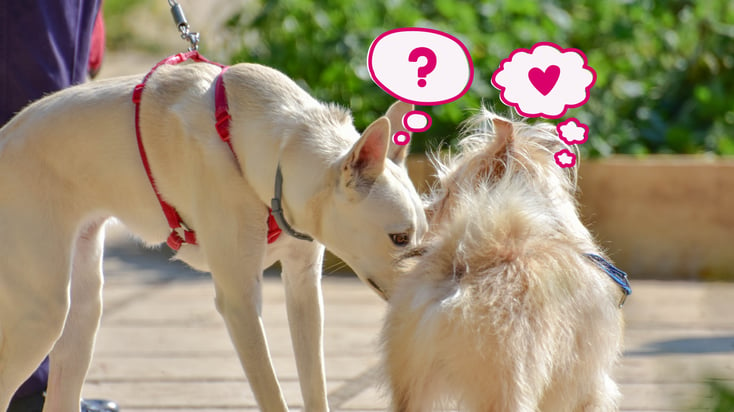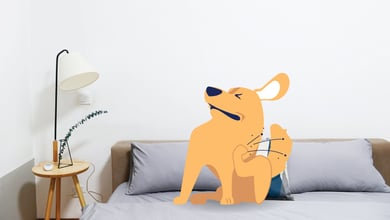Introducing Dogs to Each Other: Do’s and Don’ts

Introducing your dog to a new furry friend might seem easy at first glance, but it's more than just letting them meet. A successful introduction takes a bit of thought and attention to detail. Get it wrong, and you could have some ruffled fur on your hands.
In this guide, we'll go over the do’s and don'ts to ensure your dog's meet-up is a smooth and positive experience for everyone involved.
What to Do When Introducing Your Dog to Another Dog
When it comes to introducing your dog to another furry friend, it's important to follow the right steps for a safe and successful encounter:
1. Understanding Your Dog
Every dog has its unique temperament and comfort level when meeting new canine companions. For example, while some are naturally outgoing, others might be more reserved or hesitant around unfamiliar faces. Understanding your dog's demeanor is crucial to facilitate safe and comfortable introductions.
It's essential to be observant and watch for signs of anxiety or aggression. While they might not vocalize their discomfort directly, there are clear indicators. Look out for behaviors like growling, snarling, raised hackles, or a rigid body posture. Recognizing these cues early can help prevent any unwanted incidents and ensure a smoother introduction process.
2. Preparing for the Introduction
After understanding your dog's quirks and preferences, it's time to prep for their introduction to a new friend. Just like you'd set the mood for an important event, creating a comfortable environment for this doggy meet-up is key.
3. Choosing the Right Spot
Location plays a key role in successful introductions. Just as you wouldn't host a loud party in a quiet library, dog introductions have their ideal settings, too. Choose a neutral and spacious location, a calm park, or a large open area. Selecting a spot unfamiliar to both dogs minimizes the chance of territorial behaviors cropping up.
4. Maintaining Control with Leashes
After selecting an ideal location, ensure both dogs are on leashes. While the idea of letting them roam freely may seem appealing, it's essential to maintain control during their first meeting.
Think of leashes as safety measures, similar to seatbelts in a car. They provide you with the means to intervene swiftly should the situation require it. In dog introductions, it's always best to be prepared for any twists and turns.
5. Plan for Unexpected Situations
Dog introductions are full of variables, and having a backup plan can be invaluable. If the energy escalates, do you have tools like a water hose or barrier at your disposal?
Additionally, always having treats or toys can offer a quick distraction in tense moments. Preparedness is essential for ensuring positive interactions between dogs.
What Not to Do When Introducing Dogs
Now that we've covered the preparatory steps, let's discuss some typical mistakes to avoid during the big introduction:
1. Rushing the Introduction
Starting introductions with an immediate, close encounter can be unsettling for dogs. It's crucial not to rush this process. Instead of pushing for an immediate face-to-face, let them gradually familiarize with each other's scent from a bit of distance.
This slow approach helps ease any initial tensions and sets the tone for a more positive interaction.
2. Ignoring Body Language
When your dog wags its tail, it's easy to assume they're bursting with joy. But sometimes, that wag might be more about nerves than happiness. Being familiar with your dog's body language cues is vital.
Watch for signals like ears pulled back, a rigid stance, or them deliberately avoiding eye contact. If these behaviors crop up, it's time to step back and let things settle.

3. Allowing Off-Leash Interactions Too Soon
Starting an introduction without leashes can feel like diving into deep waters without knowing the depth. It's essential to keep both dogs on their leashes until you're confident of a friendly rapport between them. Waiting ensures a controlled environment and minimizes potential risks.
4. Punishing or Scolding Dogs During the Introduction
Dogs are sensitive to the energy around them, especially during new experiences. Scolding or using negative reinforcements during introductions can heighten tensions. This approach might not only be ineffective but also worsen the situation.
Instead, aim to guide and redirect them with understanding, ensuring their initial interactions are positive and stress-free.
5. Forcing Interactions
Each dog has their own comfort level when meeting a new friend. It's essential to avoid pushing them into an interaction if they're not ready. Instead, give them the necessary space and time, letting their natural curiosity guide the introduction.
6. Overcrowding or Overwhelming the Dogs
It's crucial to keep the setting relaxed and distraction-free when introducing dogs. A crowded or noisy environment can add unnecessary stress to the situation. Ensuring a more controlled atmosphere with fewer people around allows the dogs to focus on each other, making the introduction smoother and more positive.
Signs of a Successful Introduction
Following our guide and sidestepping common mistakes, let's identify the clear indicators that your dogs are off to a good start together.
Positive Body Language and Play
Seeing two dogs engaged in playful behavior, like chase games or play bowing, is a good sign. Relaxed bodies and freely wagging tails show that both dogs feel comfortable and at ease with each other.
Relaxed and Comfortable Behavior
When dogs feel at ease with one another, it's evident in their behavior. Whether it's gently leaning into each other, sharing toys without any fuss, or just a friendly nose-to-nose greeting, these are all signs that they're getting along well. If you see them engaging in such relaxed and sociable interactions, you know the introduction is heading in the right direction.
Gradual Increase in Interaction Time
Introducing dogs successfully is like building a friendship; it doesn't happen overnight. You'll want to see them gradually spending more time together, forging a bond at their own pace. Begin with brief, positive interactions, then slowly extend their time together as they show signs of comfort and mutual trust.
What to Do After a Successful Introduction
Even after a successful initial introduction, you must continue observing and guiding your dogs as they form their bond.
Supervised Playtime and Interactions
So, the introduction went well, and they seem to be budding pals. That's fantastic! However, while they're still getting to know each other, ensure their play sessions are monitored. It's similar to overseeing young kids at play – you want to be close by, ensuring interactions remain friendly and stepping in if things get too boisterous.
Continuing Socialization and Monitoring
A successful first introduction is just the beginning. Consistently socializing your dogs is key. It's essential to arrange regular interactions like playdates, group walks, or trips to the dog park. By ensuring regular and positive encounters, you'll help maintain and strengthen the bond between your dogs.
Celebrating the Successful Introduction
It is essential to recognize and celebrate your achievement. Reward your dogs with their favorite treats, some extra attention, and lots of praise. Reinforcing their good behavior in this manner ensures they'll associate new introductions with positive experiences, setting the stage for even more successful interactions in the future.
Conclusion
We've walked through the essential steps for introducing dogs, highlighting both the positive actions and common missteps. Every dog is different, and tailoring the approach based on their personality, the environment, and your readiness can make all the difference.






